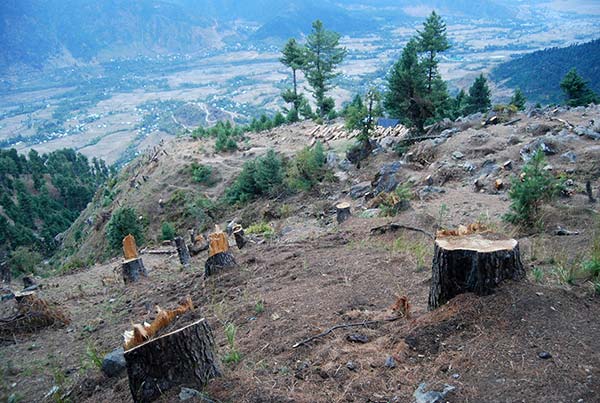
Kashmir’s ecology is facing unprecedented threats in what is unveiling to be a multi-faceted environmental offense.
By Shubhanjana Das
IN July 2021, a video from Himachal Pradesh’s Dharamshala recorded the mayhem caused by a flash flood owing to a cloudburst, claiming 10 lives. Soon after, the skies broke loose in Jammu and Kashmir’s Kishtwar in a wrathful cloudburst that swallowed 8 lives, injured 17, and left houses and cattle displaced.
These are only two of the several recent climate disasters, including apocalyptic fires, extreme heat, droughts and floods raging across the world.
This comes at the heels of the Intergovernmental Panel on Climate Change (IPCC)’s latest assessment report, almost as a manifestation of the code red alert issued for humanity owing to irrevocable temperature rise and entailing threats of erratic weather conditions.
And while the climate crisis is a global issue, it is the ecologically vulnerable areas that have to contend with the manifestations of extreme weather and climatic changes, leading to climate injustice as unfair distribution of benefits and damages related to climate change wreak havoc on certain such ecologically vulnerable regions.
The valley of Kashmir is one of them.
While the prolonged political conflict and consequent lockdowns have long put environmental issues on the backburner, now the environmental emergency looms closer than ever.
Glaciers that are the lifelines of the valley, forest cover that is of ecological as well as economic importance, and wetlands that are climate vanguards in Kashmir- the valley’s ecology is facing unprecedented threats in what is unveiling to be a multi-faceted environmental offense.
And the manifestations will only get more obvious.
Rising Temperature
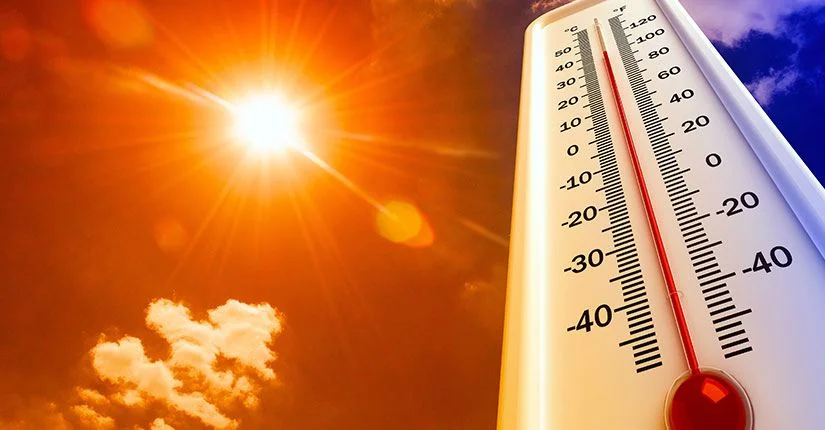
In any climate study, temperature rise is taken as one of the key determiners of predicting future threats. While IPCC’s 6th assessment states that the average global temperatures will reach or exceed 1.5°C of warming in the next 20 years, the digits are even more alarming for Jammu, Kashmir, and Ladakh as per a study in the Climatic Change journal dating July 2020.
Sonam Lotus, MET Director of Jammu and Kashmir, says that “erratic weather conditions have made forecasting a challenge in the last few years,” which is also what makes predicting cloud bursts difficult as they take place in the matter of a few hours.
He also states that the rise in temperature is certain and with it, manifestations of climate variability including erratic snowfall and rainfall.
Lotus attributes it to the shortcomings in reigning in greenhouse gas emissions.
This also implies that if the projections come true, the glaciers in this Himalayan region could shrink by a whopping 85 per cent!
Melting Glaciers
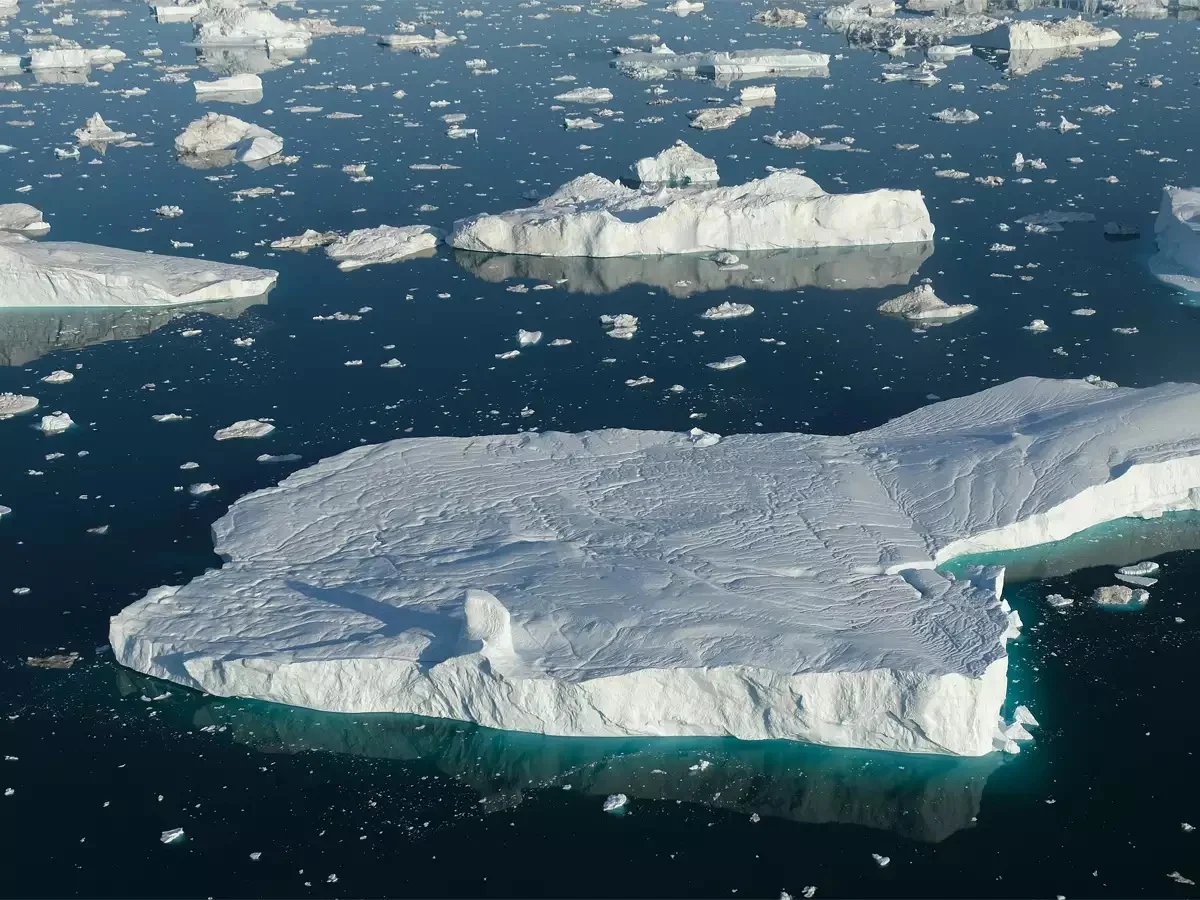
One of the most visual markers of temperature rise is the receding glaciers in the valley.
In Kashmir, 65 per cent of the water used commercially as well as for daily use comes from snow and glacier melt, which is what makes the predicted temperature rise an even greater concern to Kashmir’s ecology and economy.
In a recent first-of-its-kind study published in the journal Scientific Reports which studied over 12,000 of the 15,000 glaciers in Jammu, Kashmir, and Ladakh region for thickness and mass changes, it is stated that the region has lost about 70.32 gigatons of glacier mass during one decade of observation in this study.
Dr. Raja Muzaffar Bhat, an info-cum-eco campaigner, shares a personal anecdote wherein he met an old Bakerwal in the summer of 2010, around Tatakooti Glacier (4700 meters) in the Pir Panjal mountain range.
“He told me that the snout of the glacier was huge when he was 20 or 25 years old, but in 60 years, the Tatakoti glacier snout has receded drastically,” Dr. Bhat says.
Shrinking Agriculture

Melting of the glaciers in Jammu, Kashmir and Ladakh is going to impact the water, food and energy security with the consequent adverse effect on the dependent livelihoods.
Prof. Akhlaq Wani, Associate Professor cum Senior Scientist, Faculty of Forestry at SKUAST-K, cites a direct example by the already apparent inequitable distribution of irrigation water for paddy fields across the valley which is increasingly pushing people to move to horticulture due to the lack of water security.
Even the apple vegetation, crucial to Kashmir’s economy, is increasingly retreating towards higher elevations as lower altitude plantations no longer enjoy suitable weather conditions and water sources for a healthy yield.
“In areas where water used to be easily available for agriculture earlier, now don’t get timely irrigation as water doesn’t reach there in time,” Dr. Wani says.
“We are facing a challenge to provide an equitable supply of irrigation water to all.”
Fading Forest

According to the information available on the J&K Forest department website, forest cover constitutes 50.97 per cent of the geographical area, falling considerably short of the National Forest Policy 1988’s mandate of 66.66 per cent for mountainous regions.
And in case of Kashmir, the lag can be attributed to illicit felling, encroachment, uncontrolled cattle grazing, and degradation.
“In the last 35-40 years, our forests have suffered a lot owing to deforestation and degradation, the latter being a more serious damage inflicted on the forest wherein the felling is done in a more diffused manner as opposed to mass felling, meaning that even though the forest cover remains the same, the number of trees don’t,” says Prof Wani.
The senior scientist also notes that the Forest Survey of India’s 2019 report shows an increase in the forest area but doesn’t mention where the increase has come- which is mainly from the trees outside the forest.
Notably, the report also includes the forest cover in areas in Muzaffarabad.
For a region like Kashmir, the forest department needs increased allocation of funds and resources to deal with encroachment by people who fell trees for agricultural expansion, as pointed out by Mohit Gera, Principal Chief Conservator of Forest (PCCF) J&K and Head of Forest Force (HoFF).
Menacing Wildlife
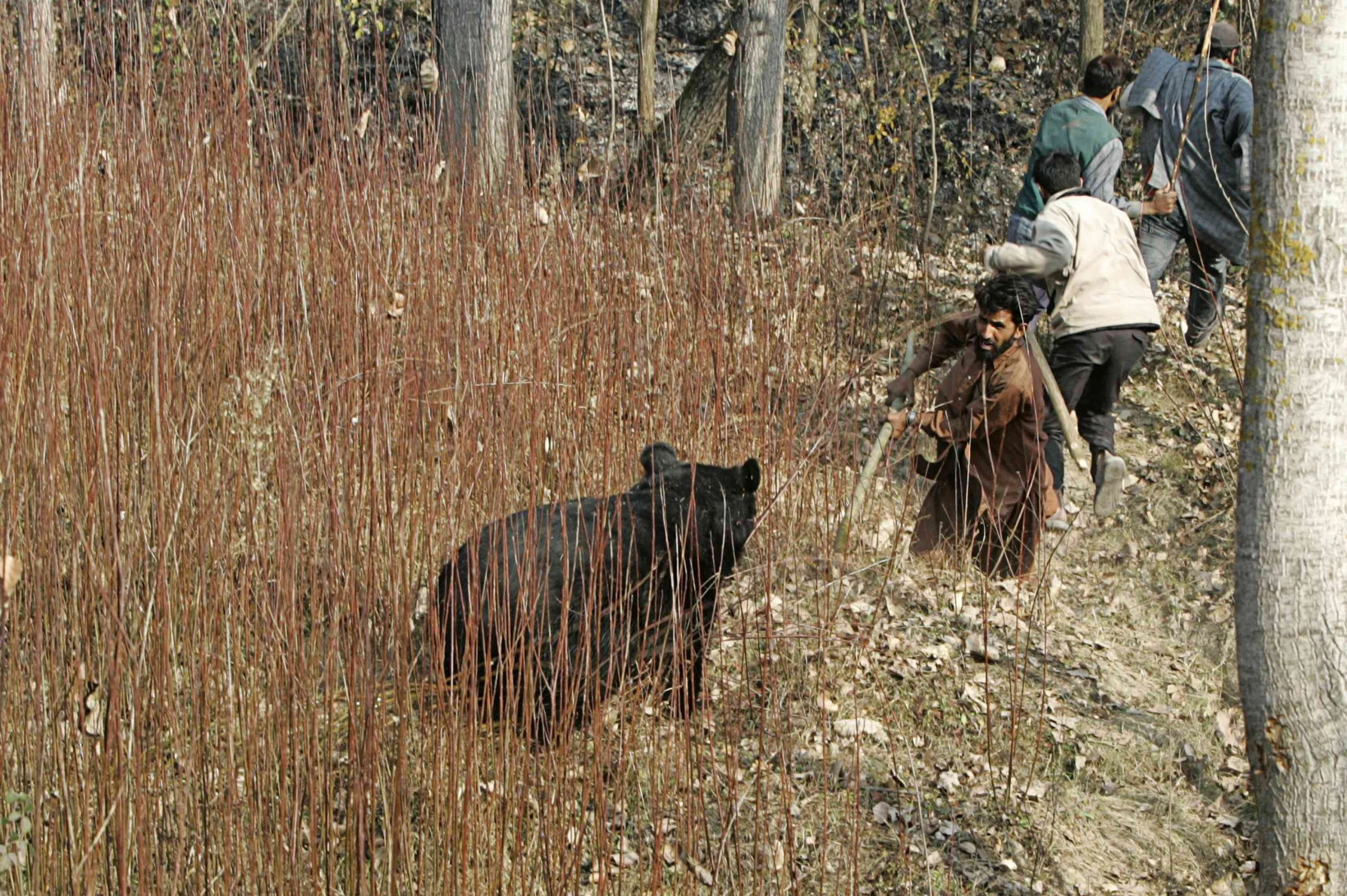
Degradation of forests is also perilous to the habitats they provide to the wildlife of Kashmir.
Rashid Naqash, Regional Wildlife Warden, notes that Kashmir has seen unprecedented behaviour in the animals because adapting to the changing climatic conditions is a challenge for them as well.
“If you see the distribution of animals like the brown bear, they used to be upto 4000m above mean sea level, but nowadays we see them on low altitudes as well,” Naqash says.
“We also see animals which used to be in forested areas now being spotted in urban environments, leading to 209 deaths since 2006 due to man-animal conflicts. We now run the risk of spotting leopards everywhere.”
While their hibernation periods have shrunk to a very brief span owing to warmer winters, retreating glaciers and drying alpine lakes are also forcing animals downstream in search of water.
However, it is not only climate change but land use planning and land cover change that has also brought behavioral change in the animals.
While unplanned construction is causing them to abandon their habitats, the slim chances of finding a safe corridor to migrate and a habitat conducive for them to thrive is posing yet another challenge for their survival.
Waning Wetlands
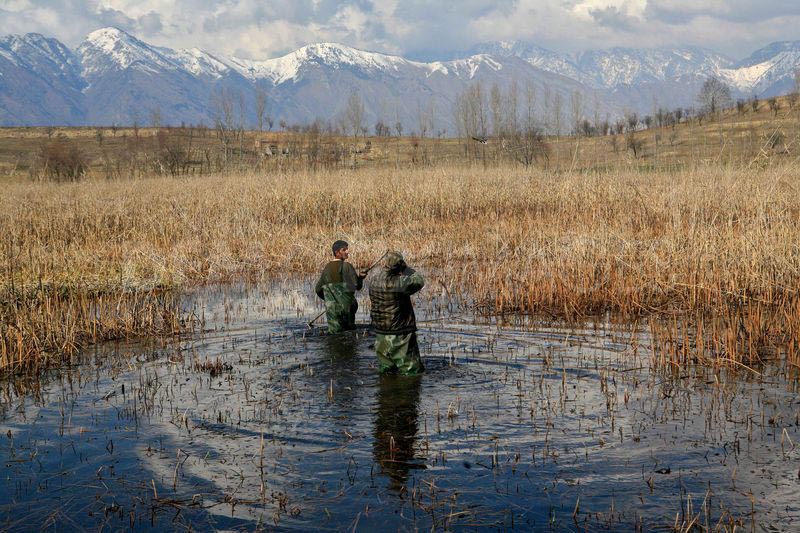
The wetlands of Jammu and Kashmir like Hokersar are highly dynamic and productive but vulnerable areas.
They provide fresh water supplies, food products, fisheries, water purification, harboring biodiversity, and regulation of regional climate.
They also act as socio-economic support systems for the city inhabitants and are valued for its native vegetation.
Hokersar, a Ramsar site (a wetland of international importance), serves as Srinagar’s shield against devastating floods and offers a safe refuge to waterbirds migrating from across Siberia, Central Asia and China that visit Kashmir valley during the winter.
However, that was no longer the case this year as a massive decline has been noted in the bird population visiting the wetland.
The reason is the progressively degrading ecology of the wetlands owing to unchallenged municipal solid waste disposal, silt deposition, encroachment and illegal construction, notes Dr. Bhat.
This not only affects their health and water quality but is also causing the overall shrinking of total covered area.
In fact, Hokersar, also referred to as the “Queen of Wetlands” is now being pushed to extinction.
Dogged Discord
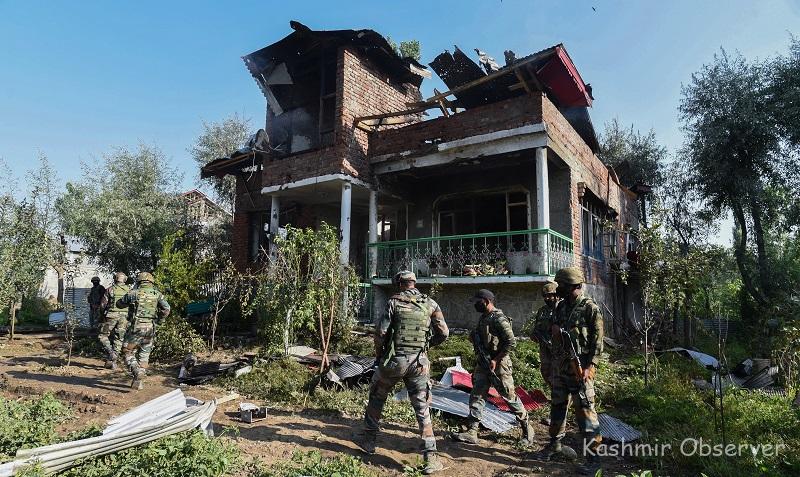
The decades-long strife in the valley and the continued dilution of laws owing to it has also had its share of negative impact on Kashmir’s ecology.
For a recent instance, between September 18 and October 21, 2019 itself, 721 hectares of designated forest land was diverted for infrastructure and other projects, with 243 hectares of it being for various uses for army and paramilitary forces in Pir Panjal or Gulmarg Wildlife Sanctuary, Kehmil, Jhelum Valley, etc.
While most of the interviewees this author spoke to refused to speak on the issue, Prof. Shakeel Romshoo, an award-winning Geo-scientist and vice chancellor of Islamic University of Science and Technology, stated that “as far as forests go, every section of the society has plundered this resource”.
General sentiment amongst the interviewees points towards an agreement that de-reservation of forest land disturbs a whole ecology, which will take no less than half a century to rehabilitate, without the assurance that the same ecology will be able to thrive there.
Mushtaq Magray, popularly known as Mushtaq Pahalgami, social, environmental and tribal rights activist, shares that the environmental concerns raised by him and his team over the years, including regarding the dilution of the mandates of Environmental Impact Assessment (EIA) of projects in Kashmir following the abrogation of Article 370, are often met with a deaf ear from the authorities, most of whom treat environmental threats with negligible emergency.
“Not only are stricter policies and laws required, but corruption in the bureaucracy also needs to be dealt with in order for those in power to treat environmental threats seriously,” he shares.
As far as policies go, Prof. Romshoo also emphasises on robust policy-making in order to act on our feet: “Owing to the advancement of knowledge in climate change studies, we need an update in the existing policies. Climate change mitigation and adaptation policies need to be continuously updated every 2-3 years in every sector.”
Romshoo’s concerns are grave on what the future holds for the unique ecology of Kashmir, and its people, and what a code red alert would mean in reality.
And while an all-out victory might be unrealistic, smaller victories in climate action executed with heightened urgency will be pivotal in saving lives, communities, habitats, and perhaps whole countries in order to prevent a future wherein the climate crisis manifests itself in lethal disasters.
Follow this link to join our WhatsApp group: Join Now
Be Part of Quality Journalism |
Quality journalism takes a lot of time, money and hard work to produce and despite all the hardships we still do it. Our reporters and editors are working overtime in Kashmir and beyond to cover what you care about, break big stories, and expose injustices that can change lives. Today more people are reading Kashmir Observer than ever, but only a handful are paying while advertising revenues are falling fast. |
| ACT NOW |
| MONTHLY | Rs 100 | |
| YEARLY | Rs 1000 | |
| LIFETIME | Rs 10000 | |












